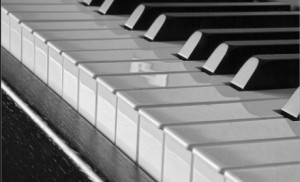Mantrap film screening: The sound of silent cinema

Milena Stanoeva
Canadian Federation for the Humanities and Social Sciences
A good musical score can inspire tears, fear, joy… It can convey greatness, desolation, or hope. The very best scores can become iconic – who among us can’t hum the Star Wars theme or recognize Psycho’s jarring screech? Yet, music is often an overlooked part of movies. The Mantrap (1926) film screening is a mini-concert, organized jointly by the Film Studies Association of Canada and the Canadian University Music Society, which aims to demonstrate the importance of musical accompaniments to cinema.
The concert will feature pianist Nicole Thomas Ziczynski, who is trained in musical accompaniment for silent cinema, and a screening of the silent film Mantrap (1926). A little-known fact is that, sometimes, silent film accompanists had to improvise their accompaniment to movies that they might have been seeing for the first time. This requires not only musical skills, including the ability to play the piano while looking at the screen, but also an in-depth understanding of how tone is set and maintained in cinema and what kind of music is suitable for different scenes.
Liz Clarke, Graduate Student Representative and Local Arrangements Coordinator for the Film Studies Association of Canada, and Kristen Yri, Program Chair for the Canadian University Music Society, are the organizers for the mini-concert. They were kind enough to answer my questions about silent cinema and the art of accompaniment.
Tell me a little about the history of sound in cinema and the ways in which music was used in silent cinema.
The short answer is film was never silent. Even in the time before synchronous sound there were always lecturers, pianists or full orchestras (depending on the size of the theatre) accompanying the film. What we are interested in is the eventual standardization of accompanists through the distribution of cue sheets with films. This means, different film companies provided theatres with cue music that either accompanied a specific films or music that corresponded with different types of scenes: war marches, chase scenes, romantic scenes, etc. The “cliché†music that you attribute to specific scenes is in part because the pianists were using similar cue sheets, or drawing from contemporary musical knowledge.
What are some of the specific skills that accompanists need to be effective in providing the sounds for a silent film?
If cue sheets are not available, accompanists quite frequently will have to improvise on the spot—seeing the film for the first time while performing—so, the skills required are as much about musical knowledge as about quick comprehension of a film’s tone and subject matter during the performance itself.
What can the relationship between music and silent cinema tell us about the experience of consuming modern film?
Contemporary musical accompaniment provides an excellent way to introduce people to the joy of watching silent movies. Watching a film with live music personalizes the experience and adds a new dimension of pleasure. It also makes one acutely aware of the effect music can have on the tone and the interpretation of a scene. Musical scores in modern films are such an important aspect of the film, yet are so frequently underappreciated or critically overlooked. Because musical accompaniment in silent film changes with every performance, we are reminded of the importance of music in shaping our film viewing experience.
Mantrap (1926): Film screening with live musical accompaniment will take place on June 1 from 16:00 to 17:30 at the John Aird Centre (WLU), room 431.
Image courtesy of Crouchy69Â on Flickr.





